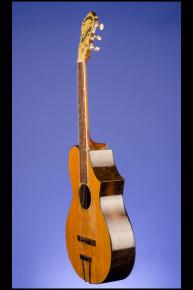The Earliest Epiphone Guitar That We Have Ever Seen.
1928 Epiphone Recording Model B (Concert).
This acoustic flat-top, arched back guitar with a 'lopped-off' treble bout is the earliest Epiphone guitar that we have ever seen. It weighs just 4.00 lbs and has a 14 1/8 inch wide, 3 7/8 deep body which features a carved solid spruce top with a 3 5/8 diameter soundhole, a three-ply laminated, highly-figured maple back and maple sides. The top and back are double-bound in black pyralin and white plastic. The soundhole is edged in black pyralin with two triple black and white rings. Three-piece maple neck with two mahogany center strips, a nut width of just under 1 3/4 inches, a scale length of 25 inches and a very comfortable medium profile. Banjo style headstock with pearloid face decorated with green leaves and with "Epiphone" and "Recoding" engraved on black banners. Also engraved in black is the model designation "B". Rear facing Grover banjo-style tuners with half-moon ivory buttons. Brazilian rosewood fretboard with nineteen medium frets and inlaid diagonally spaced pearl dot position markers. Rosewood bridge with pre-compensated rosewood saddle. Epiphone trapeze tailpiece secured to end of body by three screws.
Serial number "75" stamped in black onto the end of the neck-block. There is an old, professionally repaired, five-inch crack on the top by the bass side of the neck. This is quite stable and requires no further action. The top shows some considerable playing wear on the treble-side near the bridge. The highly figured maple back shows some finish crackling and there are many surface marks on the whole body. The black plastic strap-button plug is missing from the end of the guitar. The guitar has been expertly re-fretted with medium gauge fretwire and has the most incredibly loud and clear tone. This is the only example that we have ever seen and because of the repair on the top and the playing wear we shall only give it an (8.50) excellent rating. Housed in a later three-latch, black shaped softshell case with red felt lining (8.75).
"Around 1928 -- at the height of the Jazz Age and the height of Epiphone's reputation as a banjo maker -- Epi introduced an innovative line of five new guitars… The Recording guitars were easily distinguished from those of any other maker by their odd body shape. They had a "cutaway" of sorts to allow easier access to the upper frets, but it was not the familiar scooped-out cutaway design that became popular in the second half of the twentieth century. Instead it was more like a bout-ectomy of the upper treble bout, looking like someone had simply lopped off that part of the guitar. Curiously, the Recording series flier did not tout this innovation. Instead it extolled such virtues as a 25 inch "professional" scale length, an "adjustable tension" bridge (Gibson had patented a height-adjustable bridge), and three center veneers in the neck. Like the banjo's, the Recording guitars had alphabetical designations from A to E, but they had no full names like the Dansant or Emperor. The lowest model, the A, had had a flat top and back. The B had an arched back and flat top, and all the others had arched top and back. The tops were carved from solid spruce, in the style that Orville Gibson and the Gibson company had originated and popularized at the turn of the century. The backs of the Recording guitars also had the violin-style curvature, as noted in the flier, but they were of three-ply laminated maple. The laminated construction gave the back added strength, and it allowed for more efficient use of highly figured maple. Years later, manufacturers would mention a laminated back in passing or in cryptic terms designed to disguise a cheaper manufacturing process, but Epiphone was proud of it. The three-ply back of highly figured maple was the very first feature listed in the flier. All the Recording guitars featured a multicolored plastic-covered peghead with "Epiphone," "Recording," and the model letter engraved into the plastic… Although the idea behind the Epiphone Recording guitars -- the belief that the guitar was the coming thing -- was right on target, the execution and the timing were not right, and the Recording guitars went out withy the Jazz Age. The next wave of Epiphone guitars, however, would rock the established guitar makers and lead a revolution in the fretted instrument industry." (Walter Carter. Epiphone. The Complete History, pp. 15/16).












